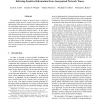Free Online Productivity Tools
i2Speak
i2Symbol
i2OCR
iTex2Img
iWeb2Print
iWeb2Shot
i2Type
iPdf2Split
iPdf2Merge
i2Bopomofo
i2Arabic
i2Style
i2Image
i2PDF
iLatex2Rtf
Sci2ools
NDSS
2007
IEEE
2007
IEEE
Playing Devil's Advocate: Inferring Sensitive Information from Anonymized Network Traces
Encouraging the release of network data is central to promoting sound network research practices, though the publication of this data can leak sensitive information about the publishing organization. To address this dilemma, several techniques have been suggested for anonymizing network data by obfuscating sensitive fields. In this paper, we present new techniques for inferring network topology and deanonymizing servers present in anonymized network data, using only the data itself and public information. Via analyses on three different network datasets, we quantify the effectiveness of our techniques, showing that they can uncover significant amounts of sensitive information. We also discuss prospects for preventing these deanonymization attacks.
| Added | 04 Jun 2010 |
| Updated | 04 Jun 2010 |
| Type | Conference |
| Year | 2007 |
| Where | NDSS |
| Authors | Scott E. Coull, Charles V. Wright, Fabian Monrose, Michael P. Collins, Michael K. Reiter |
Comments (0)

